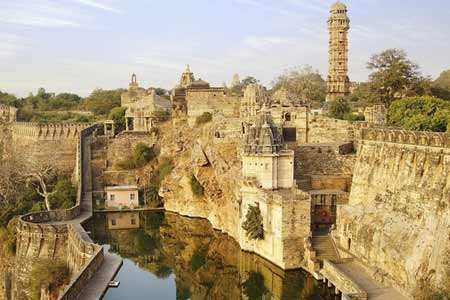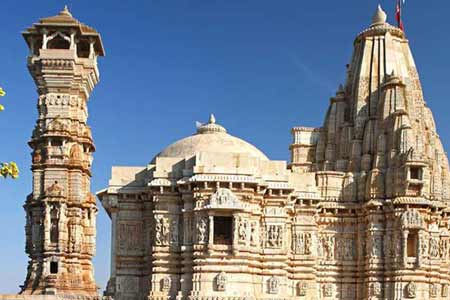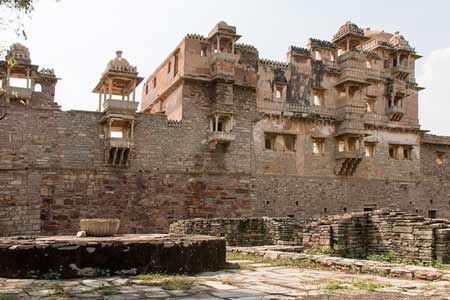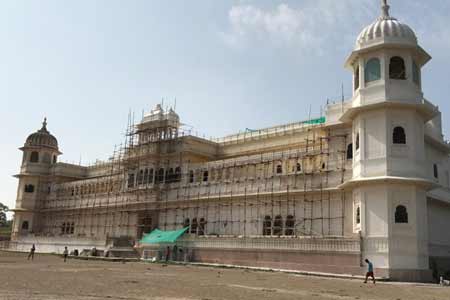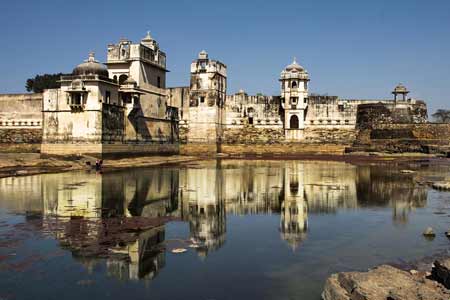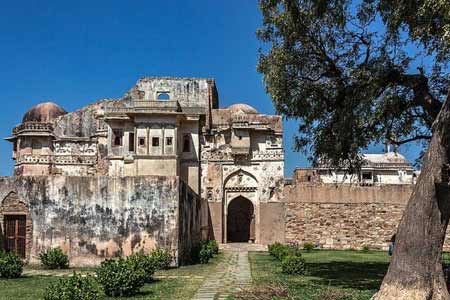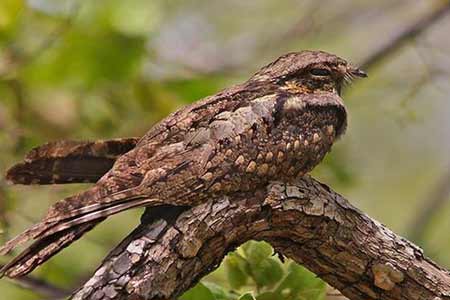
Fateh Prakash Palace
Fateh Prakash Palace is situated near Rana Kumbha Palace and close to the Badi Pol inside Chittorgarh Fort Complex.
Fateh Prakash Palace was built by Rana Fateh Singh and has been named after him. This magnificent double storeyed palace is a grand specimen of modern Indian architecture. This is an edifice with a tower on each of its four corners crowned by domed chhattries. The palace illustrates the maharaja's inclination towards art and is famous for the pillars and corridors. During the year 1968, a big portion of the palace was converted into a public museum.
The museum is divided into sections dedicated to different antiquity such as coins, art, weapons, tribal life and wood crafts of the Bassi village. A large collection of sculptures and majority of the deities is harboured within this museum. Among the sculptures, Lord Ganesh statue from Pangarh is quite attractive and is said that the statue had been created in the 8th - 9th century. Lord Indra and Jain Ambica statues are also worth seeing and were excavated from the Rashi village.
In this museum, all the weapons and equipment used in the battlegrounds of the Rajputs are displayed in broad details. There are daggers, knives, shields, axes, helmets, costumes and uniforms of soldiers, farsa and few other types of equipment required during war. One can also see some clay replicas of regional tribal clad in their traditional costumes inside the museum. Wood crafts from the local traditional designs and also a number of items from the royal families are found in this museum. Presently it has a large collection of paintings too, disclosing the historical facts attached to the fort.
Architectural Importance
Fateh Prakash Palace Museum is a splendid work of Rajputana architects craftsmanship. It is situated on the floors of Chittorgahr Fort. This fort is an ancient fort date back to medieval periods. This new palace was built later in the year 1447 AD. This is a 200 meter high, hilltop fort surrounded by an area of 962 acres of land area. This palace stands magnificent in Chittorgarh on this hilltop on the banks of Berach River. This fort palace is totally built on sand stones and rocks, which are a mix of various sizes, put to gather to form a uniform building. The specialty is that, these will be looking like a ruined stone structure. But the real architecture is this kind of irregular placement of sand stones to give more strength to the entire structure. The Fatesh Prakash is a newly renovated part of this floor as museums by the archeological department of Rajasthan. This allocation is put on many floors and in galleries on this fort to occupy the Rajputana treasures. This museum itself is an example of the great work done in Rajasthani arts and crafts.
Historical Importance
Fateh Prakash Palace Museum has the largest collection of antiquities used by the Rajput kingdom. This museum was set up in the year 1968 by the archeological department of Rajasthan and named it after the great Rajput ruler Fateh Singh. It is split in many art galleries and sections chronologically inside the museum. There are many stone sculptures on display here, which are basically the ditties of Hindu Gods. The biggest of its all sculptures is the Vinayaka Iodole which is date backed to 8th century AD this idol resembles the shape of an ancient alien which is a creative work of this creator and the craftsman. Apart from stones, there are also marvelous sculptures on woods, which are very unique to see. A numismatic section is there to showcase the ancient coins used in this sub continent from the Indus valley civilization to the modern era. All of these coins are displayed here in a chronological order. These coins are in clays, bronze, silver and gold with beautiful punch marked on it. An armory section displays the entire war crafts used by the Rajputs is displayed here, these are made up of metals and woods. A life size model of uniformed soldier with arms is on display. A special gallery is built here for displaying in models, which imitate the royal costumes and ornaments used by the royal family of the Rajputs. The ornate collections found here are glitzes in traditional designs with gems, pearls and diamonds fixed on gold range of jewels, that .This gallery is more colorful to see those models in Rajasthani dresses of royals and their local tribal people's folk dress. All to gather this museum is very important for having the vast collection of medieval era of India.
Chittorgarh Tourist Attractions
The state of Rajasthan is culturally rich and has great historical importance. Chittorgarh is one of the popular destinations for tourist travel in Rajasthan. Chittorgarh city lies on the banks of Rivers Berach and Gambini. One of the significant landmarks in the city is the Chittorgarh fort. Once ruled by the Sisodia dynasty of Mewar, Chittorgarh is reminiscent of the brave kings who ruled this kingdom.
The fort of Chittorgarh was home to a fiercely independent clan of kings who fought off three invasions. Three times the women of Chittorgarh fort committed Johar. Some of the famous warriors of Chittorgarh include Jaimal, Phata, Badal and Gora who put up a tough battle against invaders such as Allaudin Khilji and the Mughals.
The wildlife sanctuary of Bassi is situated at a distance of 5kms from the Chittorgarh. This sanctuary, which sprawls over 50 sq km, is home to panthers, mongoose, wild boars and migratory birds. There are some other places of interest such as the Kalika Mata Temple, the Vijay Stambh, the Kirti Stambh, Rani Padmini’s Palace, Fateh Prakash Palace etc.
Chittorgarh is well connected to the rest of India by the Golden Quadrilateral highway system which passes through the city. The city of Chittorgarh lies by the NH 76 and 79. The state roadways have a regular bus service which can be used to reach Chittorgarh. The nearest railhead to the city of Chittorgarh is the Chittorgarh Railway Station. The nearest airport is Udaipur which is situated at a distance of 70 km from Chittorgarh.
 +91 9549279999
+91 9549279999 
